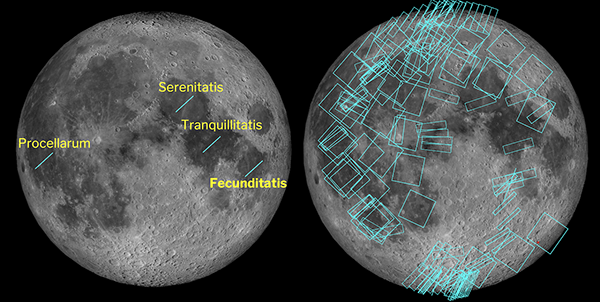Purpose of the Program
Use FORCAST to measure the emissivity feature due to water on the lunar surface.
Principal Investigator
Paul Lucey (University of Hawaii)
Proposal ID and Data Access
Proposal Abstract
SOFIA+FORCAST made an unprecedented detection of molecular water (H 2 O) on the lunar surface that raised new questions surrounding the behavior, formation, and storage of water on the Moon. Prior to this detection, it was suggested that water existed on the sunlit Moon and may be responsible for the variations observed in the 3 µm hydration band and UV water ice band ratio. However, it is unknown if the variations are caused by water or its close cousin hydroxyl (OH), which can spectrally mimic H 2 O at 3 µm. Spectroscopy at 3 µm and in the UV currently do not distinguish between water and hydroxyl. New methods were needed to uniquely detect H 2 O on the Moon. H 2 O features a fundamental bending mode at 6 µm that is strictly due to H 2 O without confusion from OH. However, the 6 µm spectral region is inaccessible from the ground, and measurements at 6 µm are lacking in existing or planned lunar spacecraft. The unique capabilities provided by SOFIA+FORCAST enabled the first detection of H 2 O on the sunlit Moon. At SOFIA’s operational altitude, the low telluric atmospheric water vapor allows for observations of the Moon at 6 µm. Data obtained during a test flight in 2018 showed a strong 6 µm emission feature at high southern latitudes. This Legacy project will address fundamental questions raised by the detection of H 2 O on the sunlit Moon and produce maps of water across the Moon at multiple lunar times of day and of geologically important locations that may indicate the presence of interior water. The maps will inform us about the migration and storage of water and may be used to determine locations with high potential for resource extraction during the NASA Artemis and VIPER programs. The characterization of water on the Moon will be applicable to the understanding of water on other airless bodies in the Solar System and exoplanets.
Observation Summary
All observations used the 3 arcmin long, 2.4 arcsec wide slit and the G063 grism in the FORCAST instrument. Target regions were covered in either a sparse map (shown as larger squares in the right-hand panel) or fully mapped riles (smaller rectangles). Accompanying each on-target observation were observations of a reference position, for which locations are shown in the panel at left. The data were reduced as described in Arredondo et al (2023), resulting in telluric-correction-improved (CRM) and reference-corrected (CRO) and baseline-subtracted (CRR) spectral images for each slit pointing. Spectral cubes in lunar co-moving celestial coordinates were created using the SOFIA pipeline for each mapped tile, as well as merged versions for multiple adjacent tiles in the same night. The CRO and CRR products will be linked to this page when available [anticipated by end of 2023]
Accurate matching to the lunar surface was accomplished using the SOFIA guide camera images and a fixed (per flight) transformation to the infrared slit. Those products are to be available in LRO Quickmap [anticipated by the end of 2023].
Publications
Reach, W et al. 2023, The Distribution of Molecular Water in the Lunar South Polar Region based upon 6-micron Spectroscopic Imaging, Planetary Science Journal (2023) [DOI]
Arredondo, A. et al. 2023, SOFIA+FORCAST Lunar Legacy Project Processing Procedure, PASP (2023)
C. I. Honniball, P. G. Lucey, A. Arredondo, W. T. Reach, and E. R. Malaret, Regional Map of Molecular Water at High Southern Latitudes on the Moon Using 6 μm Data From the Stratospheric Observatory for Infrared Astronomy. Geophysical Research Letters 49, e97786 (2022). [DOI]
C. I. Honniball, P. G. Lucey, S. Li, S. Shenoy, T. M. Orlando, C. A. Hibbitts, D. M. Hurley, and W. M. Farrell, Molecular water detected on the sunlit Moon by SOFIA. Nature Astronomy 5, 121-127 (2021). [DOI]
| Flight # | Date | CRM | CRO | CRR |
|---|---|---|---|---|
| 751 | 2021-06-23 | |||
| 826 | 2022-02-17 | |||
| 867 | 2022-05-11 | |||
| 868 | 2022-05-12 | |||
| 869 | 2022-05-13 | |||
| 870 | 2022-05-17 | |||
| 871 | 2022-05-18 | |||
| 872 | 2022-05-19 | |||
| 910 | 2022-09-07 | |||
| 911 | 2022-09-08 | |||
| 912 | 2022-09-09 | |||
| 913 | 2022-09-14 | |||
| 914 | 2022-09-15 | |||
| 915 | 2022-09-17 |
